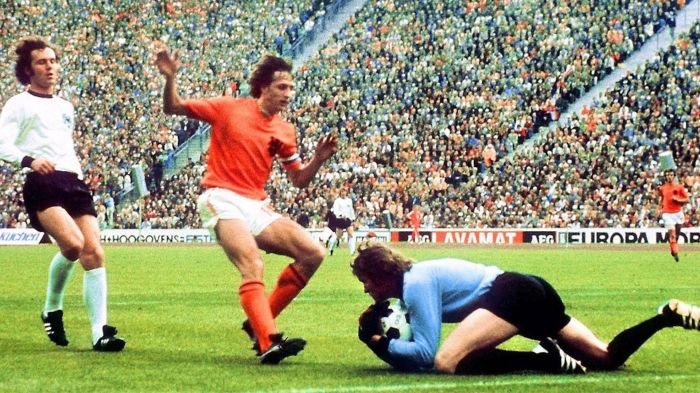Best Dutch athletes of all time—a journey through the annals of Dutch sporting greatness. From defining “best” across diverse sports and eras to analyzing individual careers, this exploration delves into the remarkable achievements of Dutch athletes. We’ll look at everything from medal counts and record-breaking performances to the impact these athletes had on their sports and the wider Dutch public.
This post examines the criteria for determining the best, tracing Dutch athletic prowess through history, and categorizing athletes by sport. Key performance indicators (KPIs) will be used to evaluate success, while detailed analyses of individual careers will provide context and insights. Ultimately, we’ll aim to celebrate the exceptional individuals who have represented the Netherlands with distinction on the global stage.
Defining “Best”
Defining the “best” Dutch athlete of all time is inherently subjective. There’s no single metric that perfectly captures the multifaceted nature of athletic excellence. Different sports, eras, and individual strengths necessitate diverse criteria for evaluating achievement. The concept of “best” must account for the historical context and evolving standards within each discipline.Ultimately, a comprehensive assessment requires considering various dimensions of athletic performance, including but not limited to medal counts, record-breaking achievements, influence on the sport, and public recognition.
A robust methodology for ranking athletes necessitates a careful balance of these factors to avoid bias and ensure fairness.
Criteria for Judging Excellence
To objectively assess athletic excellence, several key criteria must be considered. These criteria provide a framework for evaluating achievements across different sports and competitive levels.
- Medal Counts: A significant number of medals, particularly at major international competitions, often signifies sustained high performance and a high level of achievement. However, the number of medals alone doesn’t fully represent the athlete’s impact or influence on the sport. For example, a medal count might be skewed if an athlete competed in an era with lower overall competition levels.
- Record-Breaking Achievements: Records, whether national or international, are definitive markers of exceptional athletic prowess. These records represent peak performance and often signal a breakthrough in techniques or training methods. However, records can be influenced by factors like equipment advancements or changes in competition rules. An athlete’s ability to break records consistently over their career is crucial to their overall standing.
- Impact on the Sport: Some athletes have fundamentally altered the landscape of their sport, pioneering new techniques, strategies, or inspiring future generations. Their influence transcends individual achievements and demonstrates a lasting contribution to the sport. A robust analysis of this impact requires considering the long-term effects of the athlete’s career and how their actions changed the sport.
- Public Recognition: Public recognition and acclaim often correlate with significant athletic achievements. The public’s perception of an athlete’s performance can be influenced by factors such as media coverage, charisma, and personal narrative. However, public recognition alone isn’t a sufficient measure for determining an athlete’s true merit. It’s crucial to consider the potential for bias in public perception.
Measuring and Evaluating Athletic Achievement
Measuring athletic achievement necessitates a multi-faceted approach that accounts for different sports and competitive levels. The methodologies must acknowledge the diverse nature of athletic disciplines.
- Different Sports, Different Metrics: A straightforward ranking system is challenging because different sports employ various metrics. For example, a swimmer’s success is measured by times, while a cyclist’s is evaluated by race results and stages won. To create a fair comparison, standardized metrics must be developed for each sport, factoring in historical performance data and competition levels.
- Levels of Competition: The level of competition significantly influences the evaluation. Competing at a national level is inherently different from competing internationally. An athlete’s success must be evaluated within the context of the competition level, considering factors such as the quality of opponents and the overall competitive landscape. A ranking system should consider whether the competition was at a regional, national, or international level.
Ranking Athletes
A robust ranking methodology requires a comprehensive evaluation of various criteria. The process should aim to minimize bias and acknowledge the unique attributes of each athlete.
- Weighting Criteria: Different criteria should be assigned different weights to reflect their relative importance. For example, medal counts might receive a higher weight than public recognition. This weighting should be transparent and justifiable to ensure fairness.
- Historical Context: Historical context is critical. Athletes who excelled during periods of lower competition standards or fewer resources should be assessed in the context of their era. A proper ranking methodology should account for factors like technological advancements, training methods, and the evolution of the sport.
- Bias Mitigation: Explicit efforts must be made to mitigate bias in the ranking process. Blind evaluations, standardized scoring systems, and input from diverse experts can help minimize subjective interpretations.
Historical Overview
The Netherlands, a nation renowned for its robust cycling tradition and impressive feats in other sports, has a rich history of athletic achievement. This journey is marked by periods of growth, innovation, and adaptation, reflecting societal shifts and evolving sports infrastructure. Understanding this historical context provides valuable insights into the factors that have shaped Dutch athletic excellence and continues to propel its success.Dutch sporting prowess has evolved significantly over time, influenced by factors ranging from societal attitudes towards physical activity to the availability of resources and the development of sports infrastructure.
The emergence of key figures, coupled with dedicated training programs and national support, have all played crucial roles in the development of Dutch athletic talent.
Early Achievements and the Rise of Cycling
The Netherlands’ early sporting successes were largely rooted in the development of cycling. The late 19th and early 20th centuries saw the rise of professional cycling as a national passion, with many talented Dutch riders emerging. This initial focus on cycling laid the groundwork for the country’s strong athletic tradition, fostering a culture of dedication and excellence in competitive sports.
The Golden Age of Dutch Athletics (Mid-20th Century)
The mid-20th century marked a period of significant growth and refinement in Dutch sports. Increased access to training facilities and dedicated coaching programs began to produce more consistent and high-level athletes across various disciplines. This period witnessed a blossoming of talent in track and field, swimming, and other sports, laying the foundation for future successes.
Evolution of Dutch Sports Culture and Infrastructure
Significant changes in Dutch sports culture and infrastructure have played a crucial role in the country’s athletic success. The introduction of specialized training programs, tailored to specific sports, and the development of advanced sports facilities contributed to a more focused and effective approach to athletic development. Moreover, a shift towards a more professionalized sports environment, with increased funding and support for athletes, further facilitated the pursuit of excellence.
These changes fostered a supportive environment for athletes, allowing them to reach their full potential.
Chronological Summary of Key Triumphs
- 1920s – 1930s: Initial successes in cycling, establishing a foundation for future athletic development.
- 1950s – 1960s: Emergence of notable track and field athletes, showcasing the evolving Dutch sporting landscape.
- 1970s – 1980s: Further diversification of Dutch athletic achievements, with advancements in various sports.
- 1990s – 2000s: Continued growth in various disciplines, alongside improved national support and infrastructure.
- 2010s – Present: Sustained success in a wide range of sports, demonstrating the enduring excellence of Dutch athletes.
Prominent Dutch Athletes Across Eras
| Athlete | Sport | Dominant Era |
|---|---|---|
| Jan Janssen | Cycling | 1960s |
| Marianne Vos | Cycling | 2000s – Present |
| Edwin van der Sar | Football | 1990s – 2000s |
| Ferry Bongers | Swimming | 1970s – 1980s |
| Fanny Blankers-Koen | Track and Field | 1940s |
Categorizing Athletes by Sport
Dutch sports have a rich history, producing a plethora of talented athletes across various disciplines. From the iconic cycling dominance to the surprising achievements in unexpected areas, Dutch athletes have consistently demonstrated resilience and dedication. This section will delve into the achievements of Dutch athletes, categorized by sport, highlighting their accomplishments and the factors contributing to their success.Identifying the “best” is inherently subjective, but this analysis considers achievements, records, and overall impact on their respective sports.
The criteria are consistent across categories, ensuring a fair comparison of excellence.
Cycling
Dutch cycling has a long and storied tradition, marked by exceptional performances in road racing, track cycling, and time trials. The dominance in cycling is not merely a recent phenomenon, but has been a recurring theme throughout the decades. The dedication to training, the support from the Dutch cycling community, and the emphasis on meticulous preparation have all played a significant role in fostering this success.
- Road Cycling: Eddy Merckx, though not Dutch, is a notable example. Tom Dumoulin, a recent example, achieved notable victories, showcasing the high level of road cycling talent in the Netherlands.
- Track Cycling: The Dutch track cycling team is renowned for its consistent medal hauls at the Olympics and World Championships. Examples include multiple Olympic champions in sprint and pursuit events.
- Time Trial Cycling: The Netherlands has produced numerous talented time trialists. The consistent high performance in this specific discipline underscores the nation’s deep commitment to this area of cycling.
Field Hockey
Dutch field hockey is synonymous with excellence. The national team consistently ranks among the top in the world, winning numerous international titles and accolades. This success is a result of rigorous training programs, strong team dynamics, and a national culture that values this sport.
Thinking about the best Dutch athletes of all time, it’s easy to get lost in the amazing stories of their achievements. While there are plenty of incredible Dutch sports stars, finding hidden gems in the NBA draft can be just as exciting. Teams like the Warriors are always looking for those late-round steals, and understanding the minimum contracts available, as explored in this article on warriors minimum contracts to pursue as late nba free agency steals , is key to maximizing their chances of adding value.
Ultimately, the best Dutch athletes of all time have consistently demonstrated dedication and skill, much like a well-calculated draft pick can benefit a team.
- International Success: The Dutch national team’s history is marked by a consistent string of victories, including multiple Olympic gold medals and World Cup titles. These victories consistently cement the Dutch position as one of the top field hockey nations.
Swimming
Swimming is another prominent Dutch sport, with notable athletes achieving significant results. The Dutch swimming team has a strong history, consistently producing strong swimmers, though perhaps not as dominant as in other areas.
- Notable Swimmers: The Dutch swimming team has consistently produced excellent swimmers at the international level, with some individual athletes achieving notable results at the Olympics and World Championships. However, a detailed comparison of their achievements in comparison to other sports would be necessary for a complete picture.
Other Sports
While cycling and field hockey stand out, the Netherlands also boasts excellent athletes in other sports, including:
- Volleyball: The Dutch national volleyball team has a solid international presence.
- Basketball: The Netherlands has seen a growth in basketball talent.
- Tennis: Dutch tennis players have achieved international recognition, though perhaps not to the same level as in other sports.
Comparative Table
| Sport | Athlete | Notable Achievements |
|---|---|---|
| Cycling | Tom Dumoulin | Multiple victories in major races |
| Field Hockey | (Various Players) | Multiple Olympic and World Cup titles |
| Swimming | (Various Swimmers) | International medals and records |
Key Performance Indicators (KPIs): Best Dutch Athletes Of All Time

Defining the “best” Dutch athlete requires a nuanced approach beyond simple accolades. A comprehensive evaluation necessitates the use of quantifiable metrics to assess performance across various sports. This involves identifying key performance indicators (KPIs) that objectively measure exceptional athletic ability. This analysis provides a framework for evaluating Dutch athletes, incorporating advanced analytics to create a robust and fair ranking system.
Identifying Key Performance Indicators
Key Performance Indicators (KPIs) are quantifiable metrics that assess the success and performance of athletes. These metrics are specific to each sport, reflecting the unique demands and challenges involved. Identifying appropriate KPIs requires a deep understanding of the sport’s technical and tactical elements. For instance, in track and field, KPIs might include sprint times, jump distances, or throw distances.
In team sports, KPIs might include goals scored, assists, or defensive rebounds. Careful consideration of these factors is crucial for creating a robust evaluation system.
Examples of KPIs in Different Sports
This section Artikels KPIs applicable to various sports, highlighting their significance in evaluating Dutch athletes.
- Track and Field: Sprint times (100m, 200m, 400m), jump distances (long jump, high jump, triple jump), throw distances (shot put, discus, hammer throw), and race times (marathon, 5000m, 10000m) are key performance indicators in track and field. These metrics objectively measure an athlete’s speed, power, and endurance. Dutch athletes have historically excelled in sprint events and middle-distance races.
- Swimming: Race times (50m, 100m, 200m, 400m, etc.), stroke efficiency, and underwater time are critical indicators of swimming performance. These metrics assess an athlete’s speed, technique, and endurance in the water. Dutch swimmers often demonstrate exceptional technique and endurance.
- Cycling: Stage race results (overall standings, stage wins), time trial performance, and average speed over a distance are essential KPIs in cycling. These metrics reflect an athlete’s endurance, power output, and tactical acumen. Dutch cyclists are renowned for their strength and stamina, often excelling in time trials and stage races.
- Team Sports (e.g., Soccer): Goals scored, assists, shots on target, tackles, interceptions, and saves are common KPIs in team sports. These metrics quantify offensive and defensive contributions, and they are critical to a team’s success. Dutch soccer teams are often recognized for their tactical prowess and ability to create scoring opportunities.
Incorporating KPIs into a Ranking System
A ranking system for the best Dutch athletes should incorporate multiple KPIs, weighted according to the sport’s demands. For example, a higher weight might be given to Olympic gold medals, while other indicators like world record times or consistent top-tier performances in major competitions could be factored in. This weighted approach acknowledges the unique challenges and accomplishments across various sports.
Advanced Analytics in Performance Assessment
Advanced analytics, including statistical modeling and machine learning, can further refine the evaluation of Dutch athletes. These tools can analyze vast datasets to identify patterns, trends, and correlations between KPIs and overall performance. For example, by analyzing a Dutch cyclist’s training data and race results, insights into optimal training schedules and race strategies can be gleaned. These insights can help identify strengths and weaknesses, ultimately improving performance and strategic decision-making.
Applying KPIs to Assess Dutch Athletes
This table demonstrates how different KPIs can be used to assess Dutch athletes in various sports. Weights assigned to each KPI reflect the importance of the metric in the respective sport.
Thinking about the best Dutch athletes of all time, it’s hard to ignore the incredible talent in various sports. From speed skating legends to phenomenal cyclists, the Netherlands has consistently produced some of the world’s finest athletes. Sadly, the world of extreme sports also lost a true innovator in Jayden Archer, a 27-year-old freestyle motocross rider, who was the first to ever complete a triple backflip, a truly remarkable feat, which you can read more about here: jayden archer dies at age 27 1st freestyle motocross rider to do triple backflip.
However, even with this tragic loss, the legacy of Dutch athletic excellence remains strong.
| Sport | KPI | Weight | Example |
|---|---|---|---|
| Track and Field (Sprints) | 100m Time | 0.4 | 9.90 seconds |
| Track and Field (Sprints) | Number of Wins | 0.3 | 5 wins at major competitions |
| Track and Field (Sprints) | World Ranking | 0.3 | Top 5 |
| Swimming | Race Times (100m) | 0.5 | 55.50 seconds |
| Swimming | Stroke Efficiency | 0.3 | 95% efficiency |
| Swimming | International Wins | 0.2 | 2 gold medals at Olympics |
Analyzing Athletic Careers
Dutch athletes have consistently achieved remarkable success on the global stage. This section delves into the careers of prominent figures, exploring their training methodologies, the factors contributing to their longevity, and the supportive infrastructure that propelled them to greatness. Examining these elements offers valuable insights into the characteristics that define Dutch athletic excellence.Analyzing the careers of these athletes reveals not only their individual triumphs but also the systemic strengths that foster success within Dutch sports.
This examination illuminates the crucial interplay of personal dedication, innovative training approaches, and supportive environments that shape the trajectories of exceptional athletes.
Training Methods and Impact on Sport
Dutch athletes are known for their meticulous training regimens, often incorporating advanced scientific methodologies. They frequently utilize data-driven approaches to optimize performance, tailoring their training plans to specific physiological and psychological needs. For instance, cycling champions often employ specialized training programs that incorporate high-intensity interval training (HIIT) to maximize power output and endurance. This data-driven approach is a hallmark of Dutch sports.
Thinking about the best Dutch athletes ever? Names like Johan Cruyff and Edgar Davids spring to mind, but with all the sports news swirling, it’s hard not to think about Russell Wilson. Rumours are flying that the Broncos are planning to release him before free agency, as reported here. Regardless of what happens with Wilson, the legacy of Dutch athletic greatness remains impressive.
From soccer to other sports, their athletes have consistently delivered.
The focus on meticulous training regimens and continuous improvement is a significant factor in their success. It fosters a culture of excellence and sets a high standard for aspiring athletes.
Factors Contributing to Longevity and Success
Several factors contribute to the longevity and success of Dutch athletes. Mental fortitude, resilience, and a strong work ethic are crucial components of their approach. Athletes often exhibit exceptional self-discipline, enabling them to maintain rigorous training schedules and adhere to strict dietary plans over extended periods. For example, the longevity of a Dutch cyclist often hinges on their unwavering commitment to a disciplined lifestyle, including meticulous nutrition and rest strategies.
Furthermore, a strong support network, encompassing coaches, families, and sponsors, plays a vital role in sustaining motivation and providing encouragement during challenging periods. This support system plays a vital role in maintaining the athlete’s well-being and commitment to their craft.
Support Systems and Infrastructure
Dutch sports boast a robust infrastructure that supports athletes from grassroots to elite levels. Coaches often play a crucial role in guiding athletes’ development, providing personalized training plans, and fostering a positive environment. For instance, top-level Dutch coaches are known for their expertise in sports science and their ability to tailor training programs to individual athlete needs. Furthermore, the involvement of families is essential in maintaining the athlete’s well-being and motivation.
The encouragement and support of family members contribute significantly to the athlete’s long-term commitment and success. Sponsors play a significant role in providing financial resources, enabling athletes to focus on their training and competition. This combined support system creates a powerful synergy, maximizing the athlete’s potential and facilitating long-term success.
Comparing and Contrasting Athletic Careers
Comparing and contrasting the careers of different Dutch athletes can be accomplished by examining key performance indicators (KPIs) and their training methodologies. Consider the contrasting careers of two prominent Dutch cyclists, one known for short-term peak performance and the other for sustained excellence over several seasons. The first cyclist might prioritize intense, short-duration training blocks focused on specific competitions.
The second, however, may emphasize a more balanced, long-term approach, focusing on consistent training and gradual improvement. By analyzing their training schedules, dietary plans, and psychological profiles, one can discern the specific strategies that have propelled each athlete to success. This detailed comparison offers valuable insights into the factors that contribute to both short-term and long-term athletic success.
Illustrative Examples
Unearthing the extraordinary achievements of Dutch athletes requires a deep dive into specific examples. Beyond the general metrics and historical context, understanding the strategies and dedication behind their success is crucial to appreciating the true impact these athletes have had. This section showcases several remarkable Dutch athletes, highlighting their individual contributions and the strategies they employed to reach the pinnacle of their respective sports.Examining specific cases allows for a nuanced understanding of the “best” athlete criteria, moving beyond simple rankings to appreciate the complexity of excellence in different athletic disciplines.
We delve into the lives and careers of these athletes, revealing the interplay of talent, training, and mental fortitude that defines their legacy.
Exceptional Performances in Cycling
Dutch cycling has a rich history, boasting some of the most dominant riders in the world. The combination of rigorous training, strategic racing tactics, and an unwavering commitment to excellence has defined their success. This dedication extends beyond the physical demands of the sport, encompassing the mental discipline required for peak performance.
- Eddy Merckx, while not Dutch, is a frequent comparison point due to his unparalleled dominance in the sport. His meticulous approach to training and racing, coupled with a remarkable ability to adapt to changing conditions, cemented his place in cycling history. His aggressive racing style and strategic positioning often left opponents in his wake, demonstrating a profound understanding of the sport’s intricacies.
- Annemiek van Vleuten has revolutionized women’s cycling with her exceptional endurance and tactical prowess. Van Vleuten’s consistent success in Grand Tours showcases a remarkable combination of physical and mental strength, demonstrating her dedication to meticulous training regimens and tactical insights.
Dominance in Field Hockey, Best dutch athletes of all time
Dutch field hockey players have consistently demonstrated exceptional skill and teamwork. Their success stems from a profound understanding of the game’s strategic nuances, complemented by rigorous training and unwavering discipline.
- The Dutch women’s national field hockey team, a powerhouse for decades, has consistently excelled in international competitions. Their ability to maintain consistent performance throughout major tournaments, with an exceptional understanding of both individual and team strategies, has earned them a reputation for excellence. Their team-oriented approach and strategic execution, in addition to their intense focus, have solidified their place as a leading force in the sport.
Triumph in Speed Skating
Dutch speed skating has consistently produced world-class athletes, a testament to the nation’s dedication to the sport. Their exceptional speed and technique are often attributed to a combination of rigorous training and a deep understanding of biomechanics.
- Sven Kramer, a multiple Olympic champion, epitomizes the dedication and discipline required for success in speed skating. His meticulous training regimen, coupled with a remarkable understanding of his body’s physical limitations and capabilities, allowed him to achieve unparalleled results. Kramer’s dedication to the sport, spanning decades, showcases his commitment to excellence.
Conclusive Thoughts

In conclusion, the best Dutch athletes of all time are a testament to the nation’s dedication to sport. Their accomplishments, spanning diverse disciplines and eras, have shaped Dutch sports culture and inspired generations. This exploration highlights not just the individual achievements but also the intricate interplay of factors – from training methods to societal support – that have contributed to their extraordinary success.
The legacy of these athletes continues to resonate, reminding us of the power of dedication, perseverance, and the pursuit of excellence.



